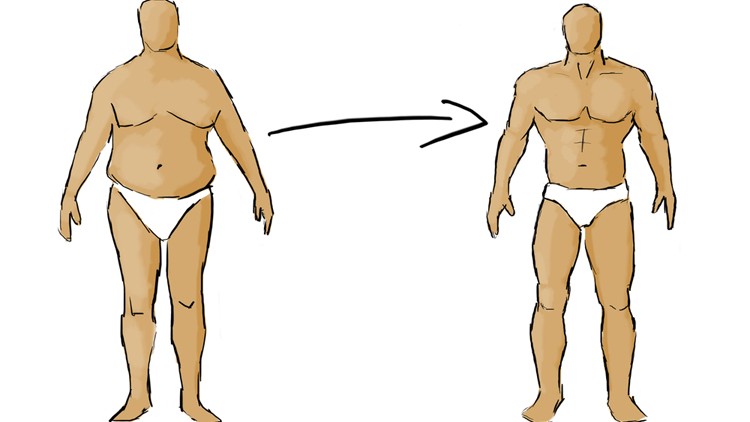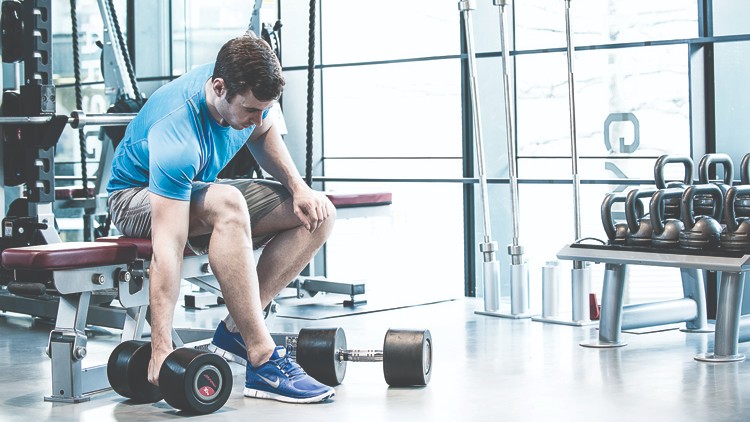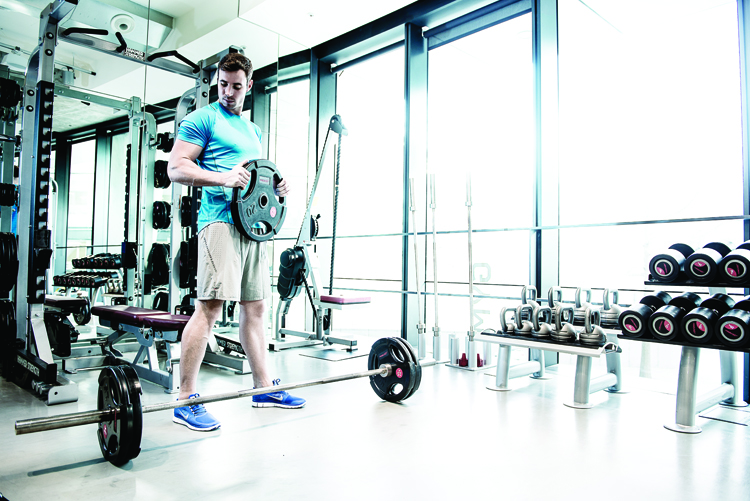Burning fat and losing weight: The truth
You want to lose fat, but can anyone agree on how you should do it? MF consults the experts on the most controversial fat-loss questions

Should I lift heavy or do circuits?
Metabolic conditioning - or ‘metcon’ – circuits containing lots of moves with very little rest makes you sweat, tires you out and seems to melt fat. But can a few focused reps with super-heavy weights burn fat more efficiently?
Lift heavy and use finishers
‘Metabolic-style workouts can be great for fat loss in the short term, but their effects last only so long. I find combining strength work with short metabolic “finishers” has the greatest effect on fat loss. The strength work helps you maintain and build lean muscle, which increases your metabolism, while the short finishers help to drive the metabolism a little higher and help stop you getting bored with your workouts.
‘A good finisher is a farmer’s walk or a similar loaded carry. When it comes to metabolic work, try using work periods of 30-40 seconds – this will take you into lactic acid territory, which can help with fat loss. Also try alternating upper and lower body for an extra twist. Start with a 2:1 rest-to-work ratio.’
Join the resistance
‘I came into the fitness industry via bodybuilding, so I’ll always prescribe resistance training. It elevates growth hormone production and decreases levels of the stress hormone cortisol, creating a situation that’s ideal for burning fat. Resistance training also creates an effect known as excess post-exercise oxygen consumption or EPOC, which leads to increased calorie burning for the next 24 hours. Having said that, the way you should train for fat loss is very different to how a strict bodybuilder trains. Stay away from isolation moves and stick to compound exercises such as deadlifts.’
Use energy depletion
Sign up for workout ideas, training advice, reviews of the latest gear and more.
‘The training plan I recommend is based on your starting point. If you’re trying to get from 10% body fat to 8% then isolation exercises are OK, but if you’re 20% then stick to big compound lifts such as squats and deadlifts. For fat loss I tend to use one low-rep [four to six reps] strength session, and three high-rep “energy depletion” sessions in the same week. Remember, as your strength goes up, you’ll be able to handle bigger loads in the high-rep sessions, which means faster fat loss.
‘If you’re aiming for energy depletion, hit as many muscle fibres as possible – for example, a circuit of two lower-body and two upper-body exercises. Try squats, dumbbell shoulder presses, Romanian deadlifts and bent-over rows, with a rep range of 12-15 per exercise and keeping the rest low – 20 seconds between moves, 60 between circuits.’
Get the best of both worlds
‘The key fat-loss benefit of heavy lifting lies in increasing your muscle mass, which means your body uses more calories. For fat loss, though, it’s hard to beat metcon-style workouts, such as CrossFit’s “Cindy” routine: five pull-ups, ten press-ups and 15 squats, as many times as possible in ten or 20 minutes.
‘If you’re just starting out, they’re a great way to have an intense workout without risking injury. And at the same time you can work on your heavy lifting technique until you do squats, deadlifts and pressing with good form. Once at this level, you can combine the two in a workout such as “Fran”, which combines a bodyweight movement (pull-ups) with a weighted movement (a squat that goes straight into an overhead press, known as a thruster).’

How often should I eat?
For years, traditional wisdom held you should eat six or seven times a day and never skip breakfast. Now there are claims that 24-hour ‘fasts’ might be more effective. So what’s right for you?
Three squares are fine
‘The theory that eating frequent small meals is best came from a misunderstanding of the thermic effect of feeding (TEF). This is the amount of energy your body requires to digest food, which typically accounts for 10% of overall calorie intake. It was thought that by eating six meals you were stimulating your metabolism throughout the day, but we now know TEF is a result of calorie intake – so if two guys both eat 3,000 calories a day but one eats three meals and the other eats six, the TEF for both is 300 calories.
‘Your approach should suit your schedule. My preference is three to four meals a day – that gives your body enough time between meals to tap into fat stores. Keep the meals large enough make you full, which is important psychologically. On a fat-loss plan it can be frustrating eating smaller, frequent meals, because they may not be large enough to satisfy you.’
Every three hours
‘I’m wary of one-size-fits-all plans, but my recommendation generally works around a meal or snack every three hours. It’s a simple way to help people develop a mindset that food is the good guy. A person will get successful results with their diet when they absorb the correct amount of macronutrients, vitamins and minerals but I find people will stick to the three-hour rule more consistently than eating well three times a day.
‘People with a bad relationship with food are more likely to reach for the cookie jar if they feel hungry, so I prefer to build consistency. Some people get good results using intermittent fasting and low-frequency meals, but those methods require mental toughness and rarely produce better results.’
Mix meals and snacks
‘My prescription is generally to eat about every three hours, but that isn’t to say it’s a full meal every time. One “feed” might consist of nuts, for instance. However, each individual’s workload, family life or training volume might dictate they need to do things slightly differently.
‘Eating every three hours is fantastic for controlling blood sugar levels and cravings. The type of foods and in what volume change depending the person’s body-fat levels, body type and activity level. If the guy carries a reasonable level of muscle mass, his protein intake would be higher than somebody who carried next to no lean muscle. In general, eat breakfast, lunch and dinner as “meals” and nuts, protein bars, natural yoghurt and so on for your snacks.’
Think quality, not quantity
‘I’d recommend shifting your focus away from the quantity to the quality of the food. It’s true that five to six good-quality, small meals a day can help to ensure each intake of food is planned and healthy rather than unplanned, unhealthy snacking. If your personal circumstances mean that isn’t possible, stick to three meals a day, with a focus on quality.’

Should I do fast or slow cardio?
Exercising in the ‘fat-burning zone’ is a dead loss as a fat-loss tactic and most trainers recommend some sort of sprinting instead. But what’s the best approach for you – and is there ever a place for low-intensity exercise?
Stick to weights
‘I don’t tend to programme traditional sprint, cycling or rowing intervals with fat-loss clients. Not because I don’t rate them – it’s just that resistance training will usually get the desired results. If you have high levels of body fat, you should avoid too much impact on your joints, so running is a no-no. I do believe there’s a place for very low-intensity exercise, such as treadmill walking or slow cross-training, but this is solely reserved for athletes and fitness models in the final stages of photoshoot or stage preparation to burn calories without breaking down muscle tissue. For the vast majority, though, this intensity of training will yield minimal results and waste a huge amount of time.’
HIIT it hard
‘High-intensity interval training, or HIIT, is something I champion. It’s a very efficient way to burn calories around the clock and doesn’t require a lot of time. I recommend two to three HIIT workouts a week if you’re already in decent shape. Low-impact cardio is something I also recommend occasionally, especially for larger people who won’t be able to handle HIIT right away. Doing three to five power walks a week is something I think works very well for fat loss and overall health. Try doing one at lunchtime, making sure you’re going at a fairly brisk pace.’
Go high, then low
‘I always recommend high-intensity work. The biggest mistake most people make doing it is choosing quantity over quality. Guys hit the gym and feel like they’re giving it 100% day in, day out, but in most cases they aren’t recovering between sessions so even though they’re working hard, their intensity is only 80% of what it could be. Working out too frequently also causes stress and unmanaged stress can raise cortisol levels, causing fat gain around your stomach.
‘To avoid that happening, try using a high/low approach. Use the strength/finisher sessions as “high” days, when you drive your fitness and strength up. On days in between do a “low” day – an easy bodyweight/movement circuit used to get your blood pumping and recover. Moderate days don’t drive fitness or help recovery, so I tend not to bother with them.
‘If you’re fit and think you can handle it, add a high-intensity day – say hill sprints. You can also try high-resistance intervals. Get on a spin bike with a high resistance, give an all-out effort for ten to 15 seconds and then recover for 45-50 seconds. Repeat this eight to ten times and ensure each one is an all-out effort. Try not to be sick…’
Do both
‘Both high-intensity and low-intensity work can be useful if you’re strapped for time. Sprints or other high-intensity work can be a very effective way of using limited time to maximum effect. This type of work kick-starts your body into metabolic overdrive. Try wind sprints – say, sprinting for 60m, then walking back to your start point before sprinting again.
‘On the opposite end of the scale is non-exercise physical activity or NEPA. The idea behind NEPA is to include a higher level of activity into your everyday life, such as getting off the bus a couple of stops early and speed-walking the rest of the way to work. It doesn’t have the same long-term metabolic effect as sprinting, but doing it every day is fairly easy, gives you some variety and helps with your recovery.’

Coach is a health and fitness title. This byline is used for posting sponsored content, book extracts and the like. It is also used as a placeholder for articles published a long time ago when the original author is unclear. You can find out more about this publication and find the contact details of the editorial team on the About Us page.

